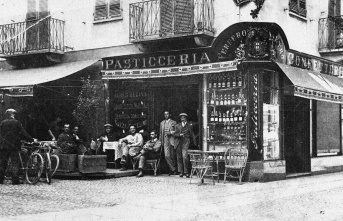Apple literally gilds the internal memory of its MacBooks. That's why most buyers go for the smallest memory variant of the Air or Pro. They currently only offer 256 gigabytes of storage space. For twice as much memory, Apple charges a hefty 350 euros extra for the Air M2, even though its graphics unit also offers two more cores. Nevertheless, 512 GB is probably not enough for anyone who wants to permanently back up photos and videos. External storage media such as hard drives and SSDs can help here and are usually cheaper than the surcharge for internal storage. However, buyers of external storage media for Macs should observe a few basic rules. In addition to choosing the right transmission protocol, this includes the size of the memory and the appropriate file format.
Basically, you should decide whether it should be an HDD (hard disk) or SSD (solid state drive). The advantage of a hard drive is a lot of storage space for little money. That was it already. Their disadvantages are mainly of a technical nature. The classic hard drive is shock-sensitive and significantly slower than SSDs. A solid state drive is flash memory. He accesses his data directly. Classic hard drives, on the other hand, still work with magnetic discs over which a reading head runs.
If you travel a lot, SSD storage is ideal because of its shock resistance. The same applies if you want to edit data directly on the external storage medium. Large video files in particular can take a toll on the user's patience on classic hard drives. If you only need a backup disk that stays in place, it can be the classic hard disk.
The most important criterion for external hard drives and SSDs is their transfer protocol. Current MacBooks all offer the luxury of Thunderbolt 3 or 4 interfaces, which are adorned in the guise of a USB-C socket and of course work with all USB protocols. And this is where it can get confusing, because USB-C only describes the shape of the socket. Compared to the somewhat chunky USB-A, USB-C is oval. However, the identifier says nothing about the USB protocol. However, this decides how quickly data is transferred from the Mac to the hard drive or SSD. One might think that the newer the protocol, the more data throughput is possible.
That's not quite right. For example, USB 3.1 Generation 1 and USB 3.2 Gen. 1x1 have a maximum data throughput of 5 gigabits per second. Think of the USB connection like a road. With USB 3.2, manufacturers use the identifier "x1" or "x2" to indicate how many streets (lanes) the USB connection has. More roads mean more data flow and less congestion. This is less important for HHDs because they work so slowly that they cannot block the data flow. Particularly fast SSDs with a read or write speed of 2000 megabytes per second (MB/s) should at least be equipped with USB 3.2 Gen. 2 x1. USB 3.0 is also sufficient for up to 950 MB/s.
The more data throughput is possible, the faster large files move. So make sure you buy an external hard drive with at least USB 3.1 Generation 1 (also called USB 3.0). USB 3.1 Generation 2 would be even better. There are manufacturers who advertise their external storage media with USB-C. You then hide in the small print that the USB-C connection is equipped with the USB 2.0 protocol – i.e. only offers a transfer rate of 480 megabits per second. The data is correspondingly slowly shifted from the computer to the disk and back.
By the way: Thunderbolt 4 is the interface with the theoretically highest data throughput (40 gigabits per second, Gbits for short), whereby the data throughput is distributed across different sources. Image signals, data and Ethernet can be transferred simultaneously via Thunderbolt. Of course, the Thunderbolt sockets can handle all USB protocols. External Thunderbolt SSDs, on the other hand, are a rarity and particularly expensive. They are only worthwhile when professionals are traveling and editing extremely large files (usually 4K video material) directly on the SSD.
Transmission protocols:
Every SSD or hard drive uses file systems to sort data. External storage media are usually formatted to FAT 32 (File Allocation Table) or ExFat (Extended File Allocation Table). The advantage of FAT 32 is that the external hard drive or SSD is recognized by both Windows and Apple computers. Unfortunately, individual files must not exceed 4 GB in size. So, for 4K video recording, you need to format the external storage to different file system if formatted in FAT32. Caution: Formatting will erase all data on the memory.
It is therefore advisable to format a hard drive for Mac when it is new and empty. Your Mac's "Disk Utility" handles this task. Here it makes sense to format the external disk to the Apple File System (APFS). It gets tricky when you want to exchange data between Mac and Windows computers. For this you need paid additional software either for your Windows computer or the Mac. If you want to read APFS storage under Windows, we recommend "APFS for Windows" from Paragon. The reverse version is available from the same software developer for Mac. It's called "NTFS for Mac". The "New Technology File System" (NTFS) is the standard file system of Windows.
Attention: You should not format the hard disk in APFS if you want to connect it directly to your video camera to save the image material on it. Most cameras do not recognize AFPS SSDs. Here you should format the SSD to ExFat if it is not already formatted as such. With ExFat, it is important for Macs not to simply pull out the external memory, otherwise there is a risk of data loss. Memory formatted on ExFat must always be ejected beforehand.
Enough theory, let's have fun. All models shown in the comparison have a USB-C connection with at least USB 3.1 Generation 1 (equivalent to USB 3.0) protocol to be on the safe side. These are two hard drives and two SSDs, which are worthwhile for Macs. There is also a Thunderbolt SSD and HDD for professional users.
The models from the manufacturer LaCie are among the classics of external hard drives. LaCie has been selling its hard drives for more than ten years. The highlight of the "Rugged" versions is the orange protective cover. According to the manufacturer, the Rugged USB-C is protected against rain and falls from up to 1.20 meters. However, the hard drive does not survive a brief immersion. Nice for Apple fans: According to the manufacturer, the Rugged USB-C is also compatible with iPads if the iPads have a USB-C interface. A data recovery service is included in the price of the hard drive for two years.
Alternatively, the SanDisk Professional with 2 TB of storage space is also available. It offers slightly better protection against environmental influences and is IP54 certified. This means that the housing keeps out dust in critical quantities and is protected against splashing water. In terms of price, both records don't take much. However, SanDisk does not offer a data recovery service.
Videographers in particular are interested in USB-C SSDs. There is a good reason for this, because microSD cards with a capacity of 2 TB are relatively expensive. It can be cheaper to connect a USB-C SSD to the camera if this is possible. This has two advantages and one disadvantage: An adapter is essential to read microSD cards on new MacBooks. This is not the case with a USB-C SSD. In addition, external SSDs read and write significantly faster than microSD cards. This also means faster transfer of large video files to the editing machine. There are also SD Express cards that work as fast as external SSDs. But they are many times more expensive than the SSD. The LaCie model with 2 TB of storage is ideal as an external SSD. It is IP 67 certified and is therefore also suitable for shooting outdoors because the SSD is dust-proof and even survives brief immersion. In addition, three years of data recovery from the manufacturer are included in the price.
The SanDisk Extreme PRO Portable SSD with 2 TB of storage space is cheaper and about twice as fast. SanDisk relies on a fast M.2 SSD for its SSD. Compared to the classic SATA SSDs, the small bars offer higher read and write speeds. However, the smaller, cheaper and faster SanDisk SSD has two major disadvantages: Compared to the LaCie Rugged, it is only IP 55 certified and therefore not as robust as the much more expensive SSD. And data recovery is not included in the price. It is therefore less suitable for professional users who film in the rain or snow, but rather for ambitious fine-weather photographers or videographers.
Tip: With this voucher you save at Saturn. Of course, the electronics store also has external hard drives and SSDs on offer.
Professionals use the professional version. In the case of LaCie, this is the Thunderbolt version of the SSD. It offers faster reading and writing speed compared to the regular version, as well as five years of data recovery service. The manufacturer relies on Thunderbolt 3 for the transmission protocol. Accordingly, data is transferred to the editing computer even faster than with the USB-C version.
A Thunderbolt hard drive makes only limited sense. This is because an HDD - i.e. a classic hard drive - never reads or writes data as fast as the Thunderbolt socket theoretically allows. So the hard drive slows down the connection. The SanDisk Professional 6TB is still suitable as additional storage for a MacBook or Mac. You don't want to take the record when you travel. Compared to the other external storage media, it is simply too bulky for that.
Note: this article was first published in October 2022.
This article contains so-called affiliate links. Further information are available here.











